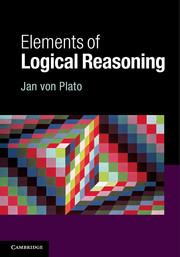Book contents
- Frontmatter
- Contents
- Preface
- PART I First steps in logical reasoning
- Part II Logical reasoning with the quantifiers
- Part III Beyond pure logic
- Part IV Complementary topics
- 13 Normalization and cut elimination
- 14 Deductive machinery from Aristotle to Heyting
- Suggestions for the use of this book
- Further reading
- Bibliography
- Index of names
- Index of subjects
14 - Deductive machinery from Aristotle to Heyting
Published online by Cambridge University Press: 05 June 2014
- Frontmatter
- Contents
- Preface
- PART I First steps in logical reasoning
- Part II Logical reasoning with the quantifiers
- Part III Beyond pure logic
- Part IV Complementary topics
- 13 Normalization and cut elimination
- 14 Deductive machinery from Aristotle to Heyting
- Suggestions for the use of this book
- Further reading
- Bibliography
- Index of names
- Index of subjects
Summary
We shall review the development of logic, beginning with Aristotle's syllogistic logic. Next the tradition of algebraic logic is described, through the work of George Boole, Ernst Schröder, and Thoralf Skolem. There follows a section on axiomatic logic with two phases, the early work of Gottlob Frege, Giuseppe Peano, and Bertrand Russell, and a second phase with David Hilbert and Paul Bernays, and up to Heyting's intuitionistic logic in 1930. That is the point right before Gentzen's development of natural deduction and sequent calculus. The emphasis is on how the logical systems work, i.e., on their deductive machinery.
Aristotle's deductive logic
Aristotle's system of deductive logic, also known as the ‘theory of syllogisms’, has been interpreted in various ways in the long time since it was conceived. The situation is not different from the reading of other chapters of the formal sciences of antiquity, such as Euclid's geometry and works of Archimedes. When Frege invented predicate logic, he finished the presentation proudly with a reconstruction of the Aristotelian forms of propositions, such as Every A is B that is interpreted as ∀x (A(x) ⊃ B (x)), with a universal quantification over some domain and the predicates A and B. Frege reproduced similarly Aristotelian inferences, such as the conclusion Every A is C obtained from the premisses Every A is B and Every B is C, in the way shown in Section 9.1.
- Type
- Chapter
- Information
- Elements of Logical Reasoning , pp. 220 - 252Publisher: Cambridge University PressPrint publication year: 2014



